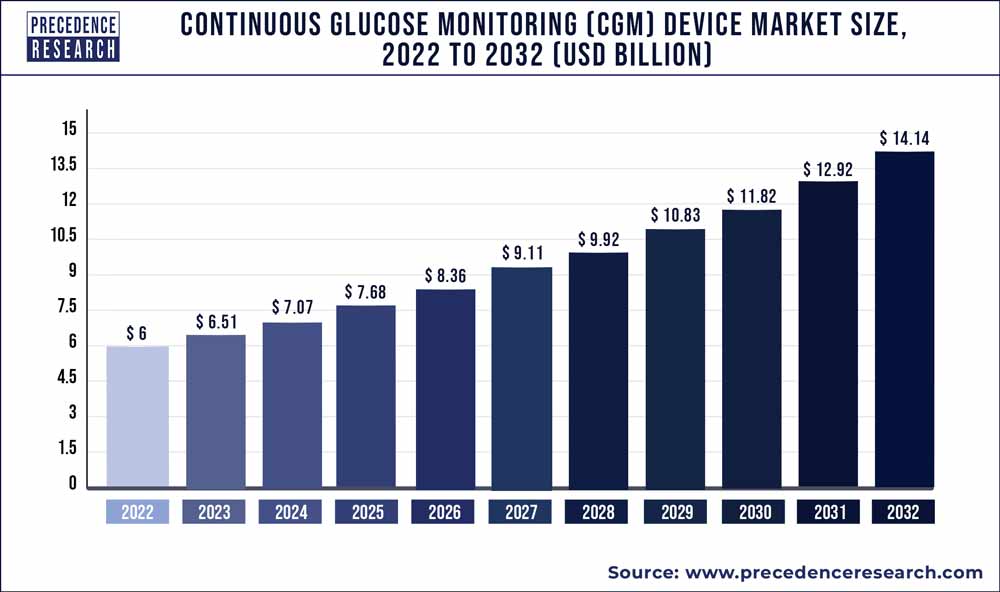Key Takeaway:
- By component, the sensors segment is register a growth at a CAGR of 10.2% from 2023 to 2032.
- By end use, the hospital segment is growing at a CAGR of 9.7% from 2023 to 2032.
The increasing awareness regarding the diabetes coupled with the growing prevalence of diabetes among the population is driving the growth of the continuous blood glucose monitoring device market. According to the International Diabetes Federation, around 700 million people will have diabetes around the globe, by 2045. The alarming rise in the number of overweight and obese people across the globe is expected to fuel the demand for the CGM device, as obesity and overweight are the major causes of diabetes.
Get Report Sample Copy @ https://www.precedenceresearch.com/sample/1374
According to the World Health Organization, more than 1.9 billion global population were overweight, out of which around 650 million adults were obese in 2016. The unhealthy food habits, lack of proper diet, busy and hectic schedules of the people, and lack of physical activities are the major contributors of the growing diabetic population. Moreover, the rising geriatric population is also a significant factor that contributes to the growth of the CGM device market. Old age population is prone to high blood glucose levels and diabetes.
Report Scope of the Continuous Glucose Monitoring Device Market
| Report Highlights | Details |
| Market Size | USD 14.14 Billion by 2032 |
| Growth Rate | CAGR of 9% From 2023 to 2032 |
| Largest Market | North America |
| Fastest Growing Market | Asia Pacific |
| Base Year | 2022 |
| Forecast Period | 2023 to 2032 |
| Segments Covered | End User, Component, Region |
North America dominated the global CGM device market, accounting for around 40% of the market share in 2020. North America is characterized by growing geriatric population, increased prevalence of diabetes, increased awareness regarding the CGM devices, increased consumer spending on the healthcare, and higher disposable income. All these factors positively contributes towards the growth of the CGM device market in the region. Furthermore, the presence of several prominent market players and various developmental strategies adopted by them has high influence on the market and the rising research and developmental activities adopted by them are expected to positively drive the market growth.
On the other hand, Asia Pacific is estimated to be the most opportunistic market during the forecast period. Asia Pacific is home to the huge population, characterized by rising awareness regarding diabetes, increasing awareness regarding the availability of CGM devices, and rising consumer expenditure on healthcare. Moreover, the rising penetration of diagnostic labs in the region is expected to augment demand for the CGM device during the forecast period. Countries like China, India, South Korea, and Indonesia are attracting FDIs in the healthcare sector owing to the favorable government policies, which is expected to dr4ive the growth of the CGM device market in the region.
Increased investments in the marketing of the CGM devices by the prominent market players significantly driven the demand for the CGM device among the population. The technological advancements in the CGM device like the introduction of improved sensors is further fueling the market demand across the globe.
The lack of awareness regarding the diabetes, increased illiteracy rate, and low income in the developing and the underdeveloped economies are the major restraining factors that may hinder the market growth in the forthcoming years.
The rising penetration of clinics, and diagnostic laboratories is expected to foster the demand for the CGM device in the forthcoming future. The rising disposable income and growing health consciousness will play a crucial role in the development of the CGM device market.
Based on the component, the sensors segment dominated the market, accounting for around 40% of the market share. The rapid adoption and extensive usage of sensor in the CGM has augmented the demand for the sensors across the globe. The sensors are considered accurate and effective in analyzing the blood glucose levels and hence its demand is high. With the advancements in the technologies, the efficiency of the sensors increased along with the increased affordability. The rising affordability will propel the demand for the CGM devices in the low and middle income countries.
Based on the end user, the home healthcare segment garnered a market share of around 42%, leading the global market. The easy availability of numerous CGM devices across the globe has fostered the growth of this segment. Further, the increased prevalence of diabetes and rising awareness among the population regarding the diabetes control and preventive measures has significantly contributed towards the growth of this segment.
Read Also: Preclinical CRO Market Size to Reach USD 11.18 BN by 2032
Some of the prominent players in the global continuous blood glucose monitoring device market include:
- Abbott Laboratories
- Dexcom, Inc.
- A. Menarini Diagnostics
- Echo Therapeutics, Inc.
- GlySens Incorporated
- Johnson & Johnson
- Medtronic plc
- Senseonics Holdings, Inc.
- F. Hoffmann-La Roche Ltd
- Ypsomed
Segments Covered in the Report
By Component
- Transmitters
- Receivers
- Sensors
- Integrated Insulin Pumps
By End User
- Hospitals
- Home Healthcare
- Others
By Demographics
- Child Population (≤14 years)
- Adult Population (>14 years)
By Geography
- North America
- U.S.
- Canada
- Europe
- U.K.
- Germany
- France
- Asia Pacific
- China
- India
- Japan
- South Korea
- Rest of the World
Contact Us:
Mr. Alex
Sales Manager
Call: +1 9197 992 333
Email: sales@precedenceresearch.com
Web: https://www.precedenceresearch.com
Blog: https://www.expresswebwire.com/
Blog: https://www.uswebwire.com/
- Esoteric Testing Market Size to Hit USD 75.54 Bn by 2032 - July 17, 2024
- mRNA Therapeutics Market Size to Surpass USD 39.99 Bn By 2033 - July 17, 2024
- Acne Treatment Market Size to Hit USD 15.86 Bn by 2033 - July 17, 2024

